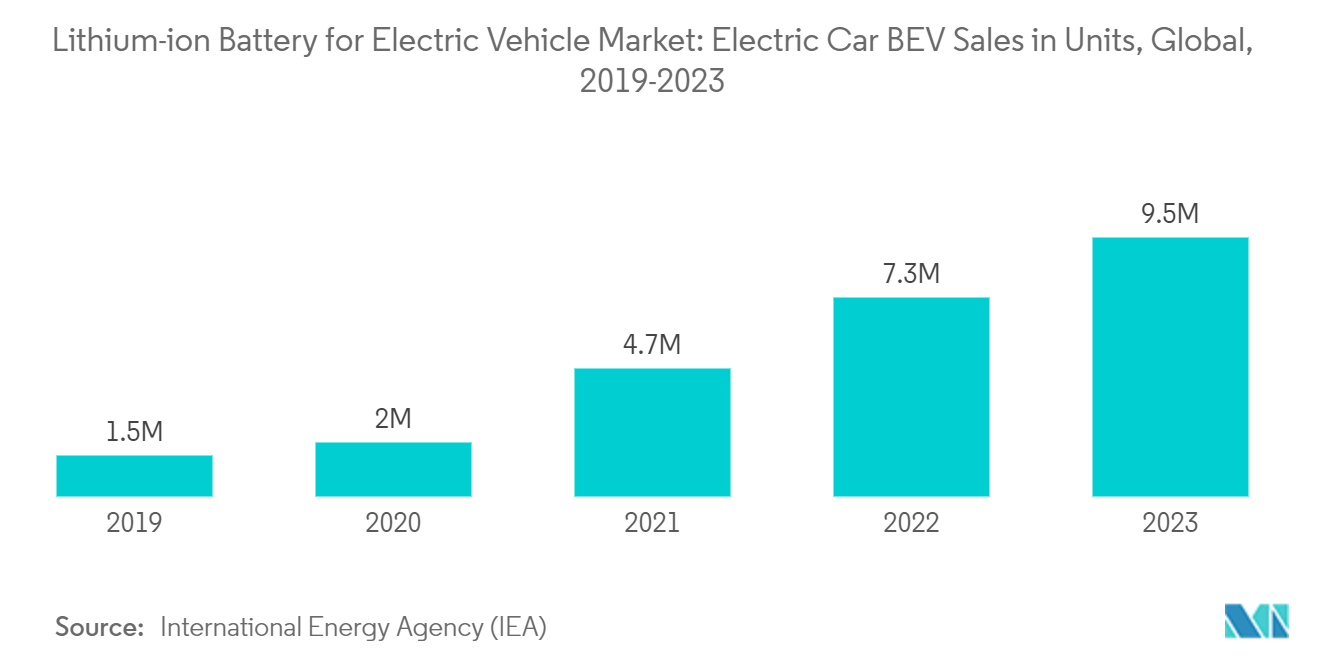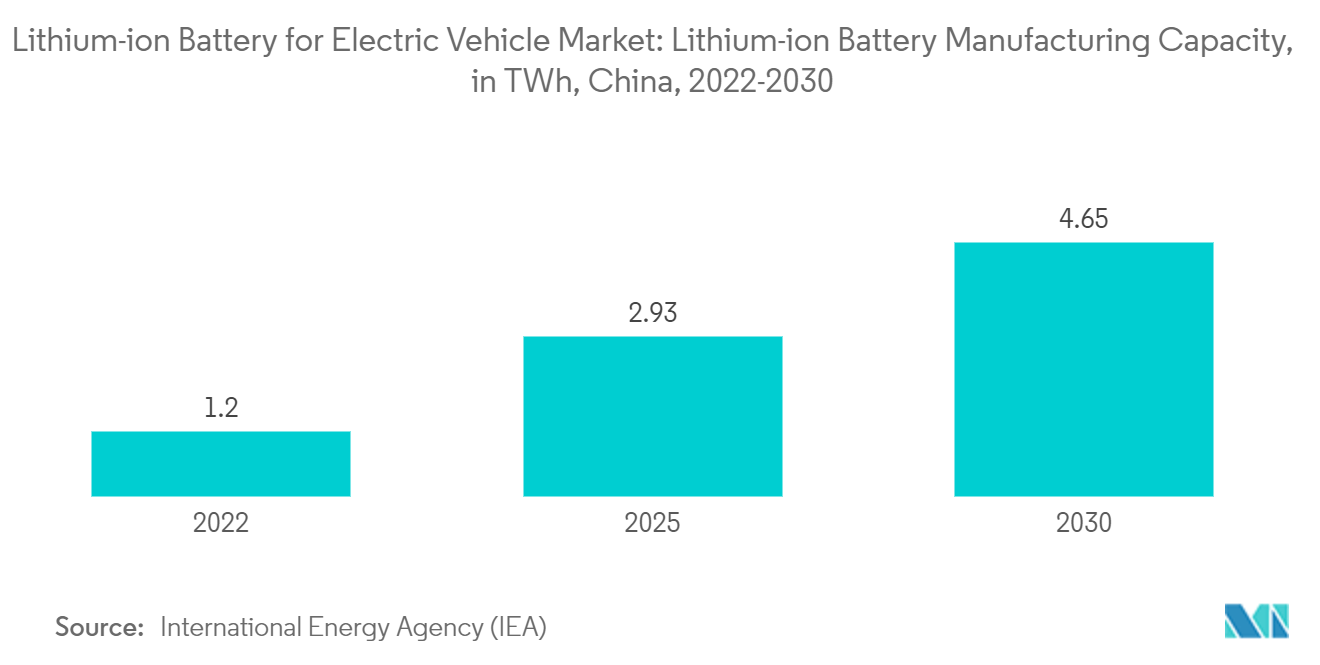Market Trends of Lithium-ion Battery For Electric Vehicle Industry
Battery Electric Vehicle (BEV) Segment to Witness Significant Growth
- Battery electric vehicles (BEVs) are also commonly known as electric vehicles with an electric motor. BEVs are fully electric vehicles that typically do not include an internal combustion engine (ICE), fuel tank, or exhaust pipe and rely on electricity for propulsion. The vehicle's energy comes from the battery pack, which is recharged from the grid. BEVs are zero-emission vehicles, as they do not generate harmful tailpipe emissions or air pollution hazards caused by traditional gasoline-powered vehicles.
- The global automotive industry has been transforming, with electric vehicles, particularly battery electric vehicles (BEVs), gaining momentum and popularity. With the growing technological advancements, government support, and increasing environmental concerns, BEVs emerged as a promising solution to address the challenges of climate change and reduce reliance on fossil fuels.
- In recent years, the adoption of battery-electric vehicles has grown significantly worldwide. Improving battery technology has led to extended driving ranges and a surge in charging infrastructure, helping overcome the initial entry barriers. Automakers such as Tesla, BYD, Tata, Chevrolet, Nissan, and Ford are vital in popularizing BEVs, offering affordable models that appeal to a broader range of consumers.
- As per the International Energy Agency (IEA), the global battery electric vehicle (BEV) cars sales were around 9.5 million units (BEV cars) in 2023, an increase of over 30% from around 7.3 million units in 2022. Similarly, the total BEV car stocks worldwide reached around 28 million units in 2023. As the sales of BEVs continue to rise, the demand for EV batteries, such as lithium-ion batteries, has become increasingly vital.
- Countries have been implementing various initiatives and incentives to accelerate the adoption of BEVs. In the United States, federal tax credits, state rebates, and subsidies helped make EVs affordable and accessible to a broader audience. Several states have set ambitious targets to phase out internal combustion engine (ICE) vehicles and promote the use of electric cars. Therefore, the growing adoption of BEVs is anticipated to boost the demand for lithium-ion batteries over the forecast period.
- Several governments plan to boost the adoption of EVs in the coming years. In May 2024, the French government set a goal for the nation's carmakers to produce two million electric or hybrid vehicles by the end of the decade. Under a new medium-term planning agreement with the government, the industry is set to agree to an interim goal of 800,000 electric vehicle sales by 2027, up from 200,000 in 2022, according to a finance ministry briefing. Carmakers aim to increase sales of electric light utility vehicles to 100,000 annually over the same period, from only 16,500 in 2022. All these are expected to create a vast demand for rechargeable EV batteries, such as lithium-ion batteries, to support the growing battery electric vehicles on the roads in the region.
- Several Chinese carmakers have been looking to set up and expand EV manufacturing and assembly plants globally to ramp up sales. For example, Chery Auto, China's largest automaker by export volume, announced on April 2024 that it signed a joint venture with Spain's EV Motors to open its first European manufacturing site in Catalonia. The production is set to start later in 2024, with junior partner Chery producing its Omoda vehicles at the plant. Carmakers are considering building car factories in Britain by 2030.
- In March 2024, the Indian government approved a new USD 500-million-worth Electric Vehicle (EV) Policy, offering a range of incentives to draw investments from global EV companies and positioning India as a prime manufacturing hub for state-of-the-art EVs. Other objectives include providing Indian consumers access to cutting-edge EV models, expanding the Make in India ecosystem, lowering production costs, and fostering a competitive domestic auto manufacturing industry. Such a scenario is expected to impact the BEV manufacturing industry positively, which, in turn, boosts the demand for lithium-ion batteries for EV applications.
- Due to the abovementioned factors, the BEV segment is expected to dominate the lithium-ion battery for electric vehicle (EV) market over the forecast period.

Asia-Pacific is Expected to Dominate the Market
- Asia-Pacific is expected to dominate the global lithium-ion battery for electric vehicle (EV) market, as the region is home to some of the world's largest and fastest-growing economies. Countries such as China, India, and Japan are experiencing a surge in the adoption of electric vehicles, where lithium-ion batteries are crucial battery chemistries.
- As per the International Energy Agency (IEA), the total EV car stocks, including (both BEV and PHEV) in China was around 21.8 million units in 2023. Similarly, India and Japan had approximately 0.15 million and 0.54 million units of EV car stocks in the same year, respectively. In 2023, China had an EV battery demand of about 417 GWh per year, or about 54% of the world demand in 2023, recording over 32% surge from 2022. This highlights the importance of the country's dominance in EV batteries.
- Asia-Pacific is also emerging as a manufacturing hub for electric vehicles and battery systems, which is expected to witness significant developments in rechargeable batteries such as lithium-ion batteries. Major automotive manufacturers in China, South Korea, and Japan are expected to accelerate the region's lithium-ion battery manufacturing capacity.
- As per the International Energy Agency (IEA), the lithium-ion battery manufacturing capacity in Asia-Pacific is expected to grow significantly in the coming years, with China leading the way. The agency estimated that the Chinese lithium-ion battery manufacturing capacity will rise to 4.65 TWh in 2030 from around 1.20 TWh in 2022.
- The region has been seeing developments in the lithium-ion batteries. In June 2024, Indian battery maker Amara Raja Energy and Mobility signed a licensing agreement with Gotion-InoBat-Batteries (GIB), a unit of China-based Gotion High Tech Co, to produce lithium-ion batteries in India. GIB EnergyX Slovakia, a joint venture between Gotion and Slovakia-based InoBat, will license Gotion's lithium iron phosphate technology for lithium-ion cells to a unit of Amara Raja.
- Under the licensing agreement, the Indian company will gain access to cell technology IP, support for establishing Gigafactory facilities, and integration into Gotion's global supply chain network. Gotion, whose largest shareholder is the German automaker Volkswagen, specializes in lithium-ion rechargeable batteries for new-energy vehicles. Indian automakers mainly import EV batteries from China and South Korea, and domestic battery suppliers have invested in developing lithium-ion battery production capabilities within the country in recent years.
- Asia-Pacific is also home to some of the world's largest producers and suppliers of critical raw materials used in lithium-ion batteries, such as lithium, cobalt, and graphite. This abundant availability of raw materials, coupled with the region's strong manufacturing capabilities, has created a favorable environment for the growth of the lithium-ion battery market.
- For instance, Indonesia holds approximately 22% of the global nickel reserves. Similarly, the Western Australia region has 24% of the global lithium reserves, which makes Asia-Pacific ideal for lithium-ion battery development and manufacturing.
- Therefore, as per the abovementioned points, Asia-Pacific is expected to be the dominant region for lithium-ion batteries in the electric vehicle market during the forecast period.


